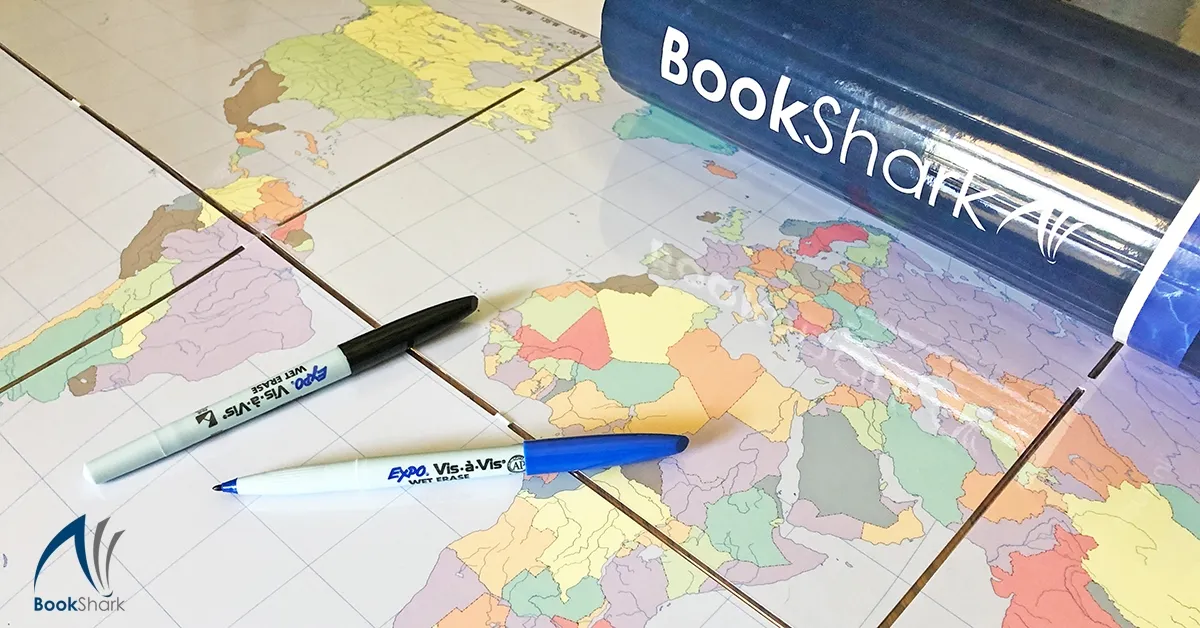We all suffer from information overload at times. When there is too much detail or too much to digest, we tend to shut down and not assimilate any of it in a meaningful way.
The same is true for students. Some learning tools are overwhelming. For example, traditional maps and atlases that have hundreds of labels can be hard to digest. There’s just so much information, students may not know what to zero in on and consequently remember little of what they see.
That’s why the Markable Map sold in the Required Resources of every BookShark Reading with History program (or All-Subjects Package) is such an amazing—yet simple—tool.
Reasons to Use the Markable Map
- The Markable Map isn’t pre-labeled like most maps. It’s so open-ended that you can use it for dozens of different applications.
- By doing the work of locating and labeling places on their map, students are more likely to remember what they are learning.
- We tend to remember information better when it has a specific purpose or connection to what we are learning. The Markable Map gives you a way to create that context. You read; then you mark.
Fantastic Features of BookShark’s Markable Map
- This 23″ x 34″, full-colored map can hang on the wall so your students can reference it easily. Tip: If you don’t have room on your wall, pin it to a piece of foam board and store it under a bed. You can prop it up on an easel or a chair during school hours.
- It’s laminated, so you can use it again and again for a variety of activities.
- The map has two sides: the United States and the world.
- All of your students can use it, from kindergarten through high school.
Markable Map Learning Activities
You can use the map for a variety of learning activities with students of all ages across subject areas. You’ll only need a few supplies and resources such as Vis-a-Vis® markers, an atlas, the Internet, and of course, the Markable Map.
BookShark Instructor’s Guides include suggested mapping activities, so you’re covering geography in an integrated way if you follow the lesson plans. Below are some of the kinds of mapping activities that you may encounter. If geography is a favorite (or a weak spot), you may want to add extra mapping fun into your homeschool routine.
For any of these activities, you can have your students include a map key or legend if desired.
Geography
- Learn about the different kinds of landforms and geographical features, then find examples on the map and label them with the term. Create a geography dictionary in a notebook to go along with your study. Draw a picture of the landform, such as a fjord, and define it.
- Label parts of the map such as lines of longitude and latitude and the equator. Learn what these terms mean and why they are important.
United States
- Write the name of the state you are studying and place a star on the capital of the state and label it. Also mark and identify major cities. Include geographical features such as mountain ranges by drawing triangles where they are located.
- Choose a color for each region of the United States. Outline each state as you study it with a Vis-a-Vis® marker corresponding to the color of the region.
- Draw a symbol, such as an outline of a car, on each state that you have visited. This is also a great activity to do as you plan a vacation showing where you will be traveling.
World
- Label continents, oceans, and countries as you study them.
- During the Olympics, place the olympic rings on the map where the games are held. Learn about what the rings stand for, then using colors corresponding to the rings, outline those regions on your map.
- Add time zones to the map. Find out more about the history behind time zones and why we have them. Be sure to label the International Date Line.
- Learn about volcanoes, then draw symbols of them around the world and label the Ring of Fire.
History

Draw the paths of explorers. Include those who explored lands such as Lewis and Clark, as well as those who traveled across the oceans.
Literally track the building of the Transcontinental Railroad as you learn about it.
Use your map to show where Native American tribes were located across the United States as westward expansion became the focus.
As you study the history of different parts of the world, add a symbol or simple stick figure style picture on your map where major events took place.
Show the movement of troops during wars. Talk about the obstacles the geography of the area might have caused for them.
History is being made everyday, so locate and label places you hear about in the news.
Other Subjects
- When you read about a place in a book, locate it on the map. You can even draw a small copy of the book’s cover to attach to the map.
- When writing a fictional story, consult the map to find a setting for your story. Think about how the geography of that area would affect the character’s lives.
- Use the Markable Map as a visual for a presentation.
- Learn about graphing using the lines of longitude and latitude. Give students coordinates and have them draw a circle on the map where those coordinates meet.
- Learn about scale and include it in the map keys they create.
- Reference the Markable Map when visualizing math problems dealing with distance.
- Have students create their own word math problems using the map.
- When studying animals, put small pictures of them in the region they are most predominant. Or track migration routes of animals across the world.
- Draw small pictures of inventions and place them on the map where they were invented,
- Label the places different types of music were created or emerged from classical to jazz to rock.
As your students study different subjects, brainstorm your own family’s ideas for how to use the Markable Map in your homeschool. You’ll discover it’s an inexpensive investment that yields valuable learning opportunities for the entire family. s with our children. Draw out the topics they are interested in and can relate to, ask questions that spark opinions and more questions, and get excited about what will happen next. Your kids will follow suit and you’ll be digging in and having valuable discussions with them before you know it.

